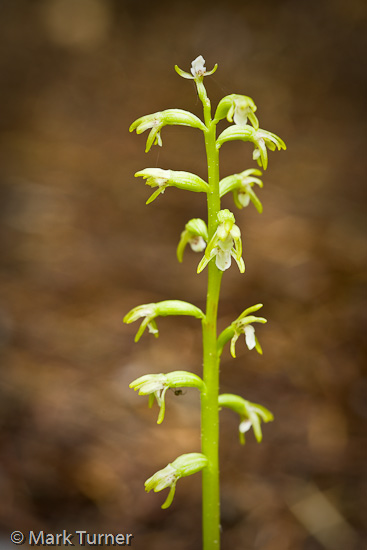Yellow Coralroot
Yellow Coralroot, Corallorhiza trifida, is one of four species in this genus found in the Pacific Northwest. It’s also the one that has been eluding me for several years. Back in 2003 and 2004 when I was chasing wildflowers all over Washington and Oregon I spent parts of several days hunting for it in places where I’d been reliably informed that it grew. Each time I came up empty and in the end Phyllis and I left it out of Wildflowers of the Pacific Northwest.

On June 20 I finally found it along the Goat Mountain trail in the North Cascades at about 3500′ and created the photo here, as well as many others. Yellow Coralroot grows in moist forests and can live in deep shade because it is myco-heterotrophic and derives most of its nutrients from a fungus. Other coralroots share this non-photosynthetic way of getting their food.
The place where most of the specimens were growing was a depression on a relatively flat bench part way up the mountain, just before the trail starts climbing again. If you know the trail you’ll recognize the spot. Other plants growing in the area were tiarella and oak fern. I’d passed this spot several times on previous hikes, but never in mid-June when the coralroot was blooming. Once my hiking companions and I saw the first ones we spotted many more scattered through the woods along the trail for next 1/4 mile or less.
Yellow coralroot certainly isn’t rare, but it is rather infrequent. It has a rather wide range and is found in all northern states and the Canadian provinces according to USDA PLANTS.
This is the least showy of the four northwest coralroots, with its yellow-green stem that blends easily with surrounding vegetation. It’s easy to miss, and you’ll have to get up close to see the diminutive flowers. Once you see it you’ll immediately recognize it as an orchid.
The photo was made with a 100mm macro lens and a 1/5 sec. shutter speed in the dark forest. Even the slightest breeze created too much motion and I exposed a lot of frames to get a few that are sharp. If I’d carried my flash on this trip I would have used it for additional light and to freeze the motion. At least the wind wasn’t strong that day. I didn’t attempt a detail of a single blossom as the additional magnification would have also magnified the subject moving.
One other note: Corallorhiza is also spelled Corallorrhiza in some references, including our book.


Fun to find you and your lovely orchid. I enjoyed learning more about it. Three posts back on my blog I posted two coralroot orchids that I found in our forest. They are different types. I never even wondered how they survive in the shade. Thank you for that. Your is such a lovely color!